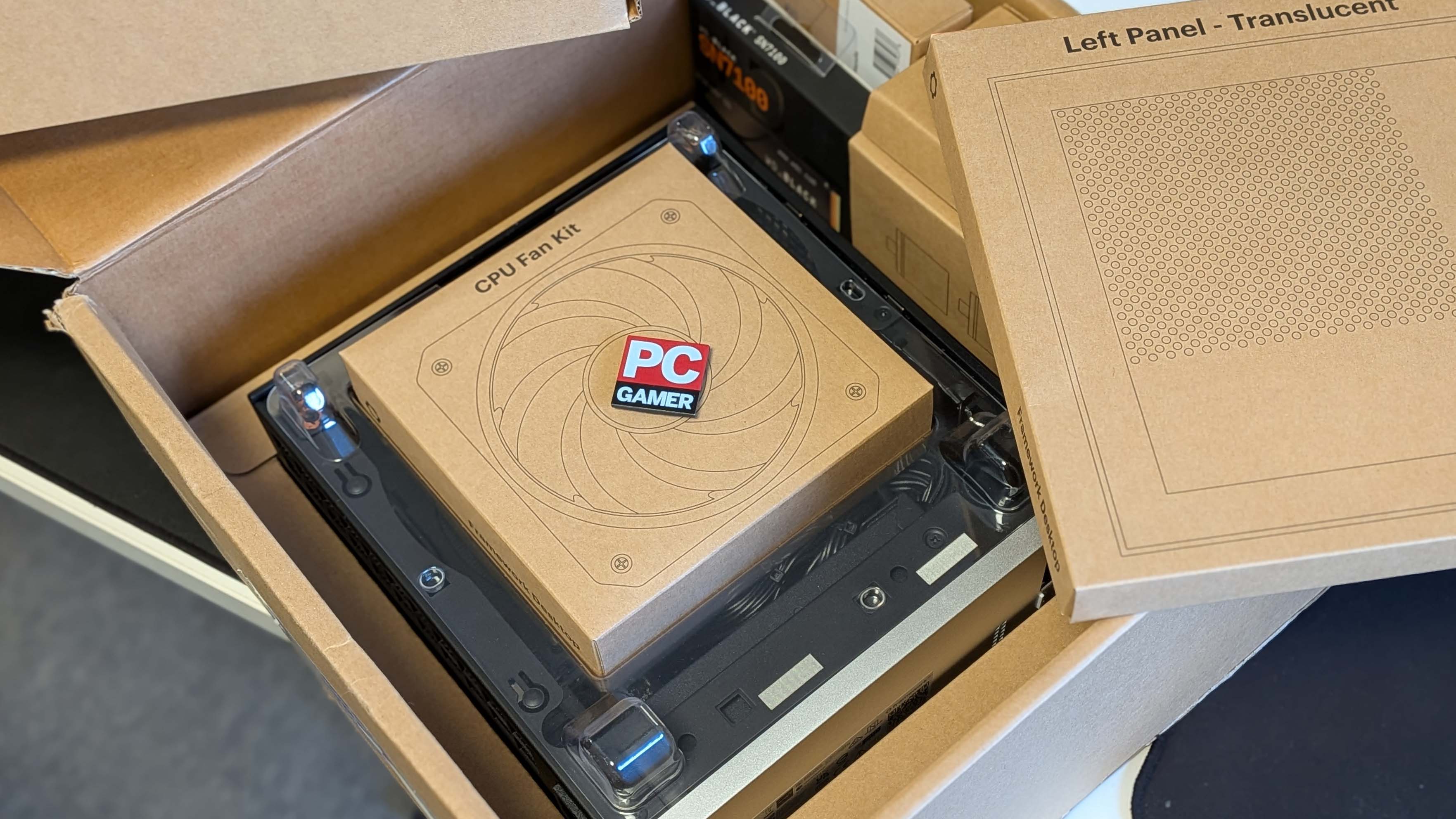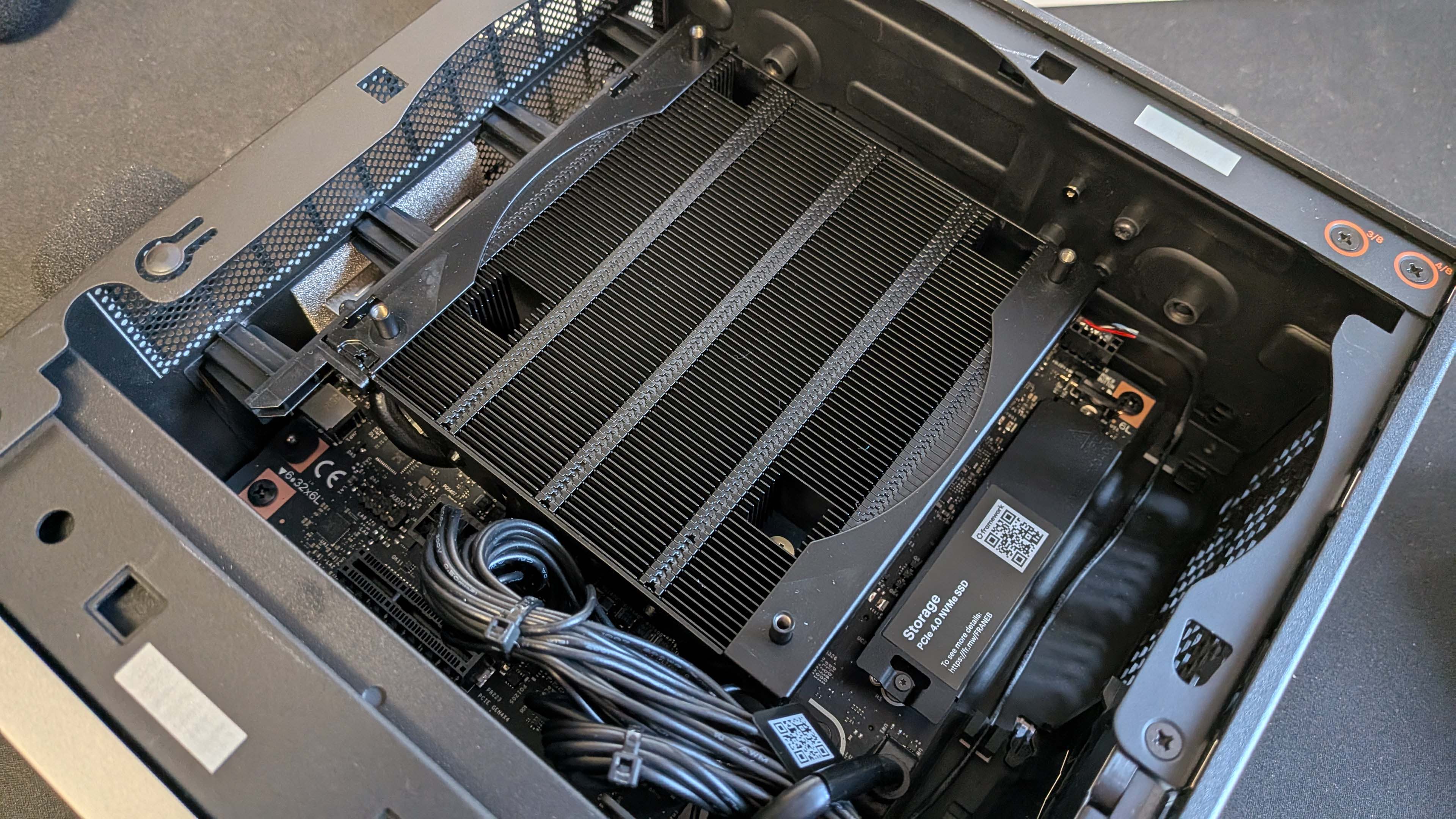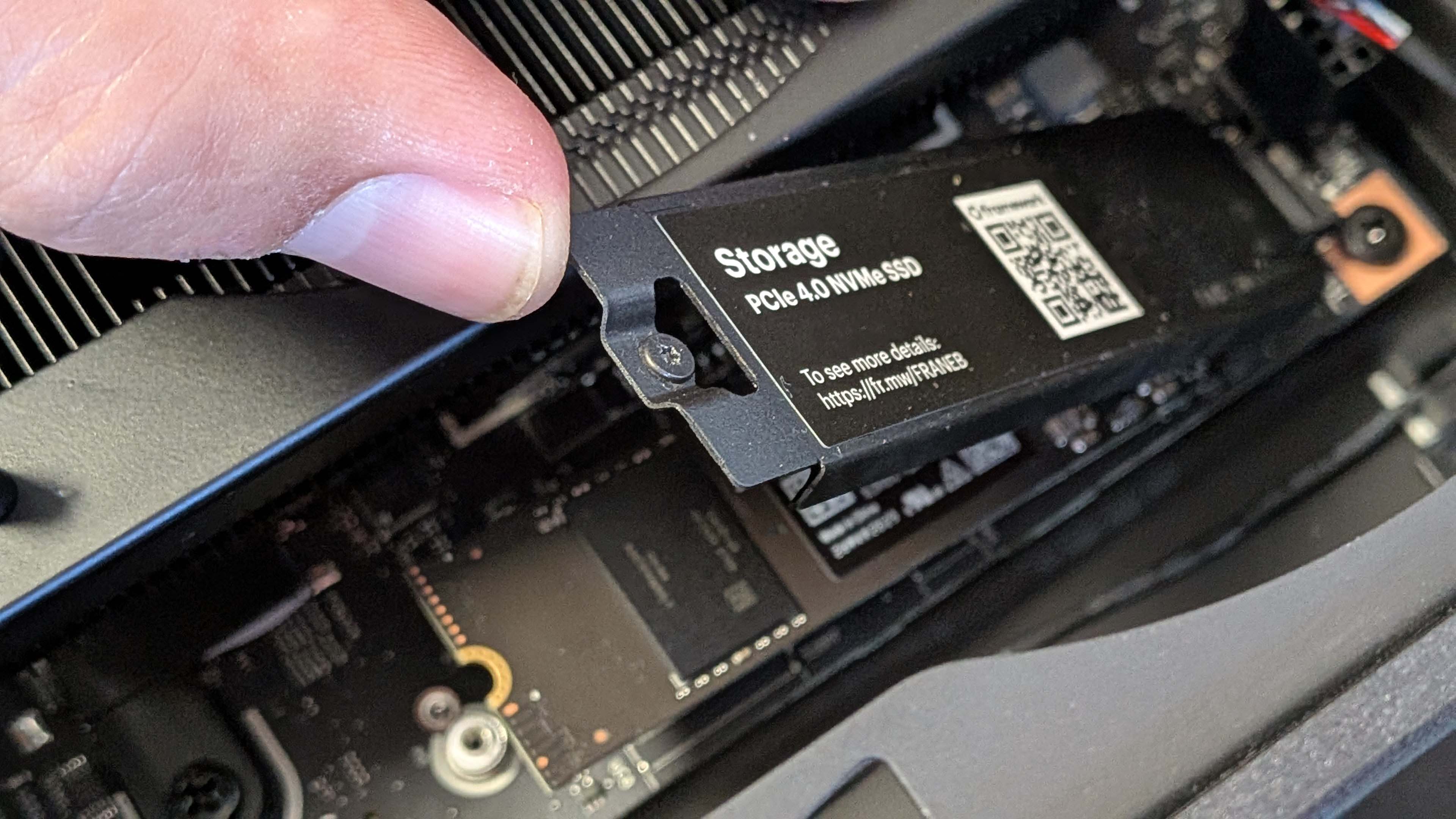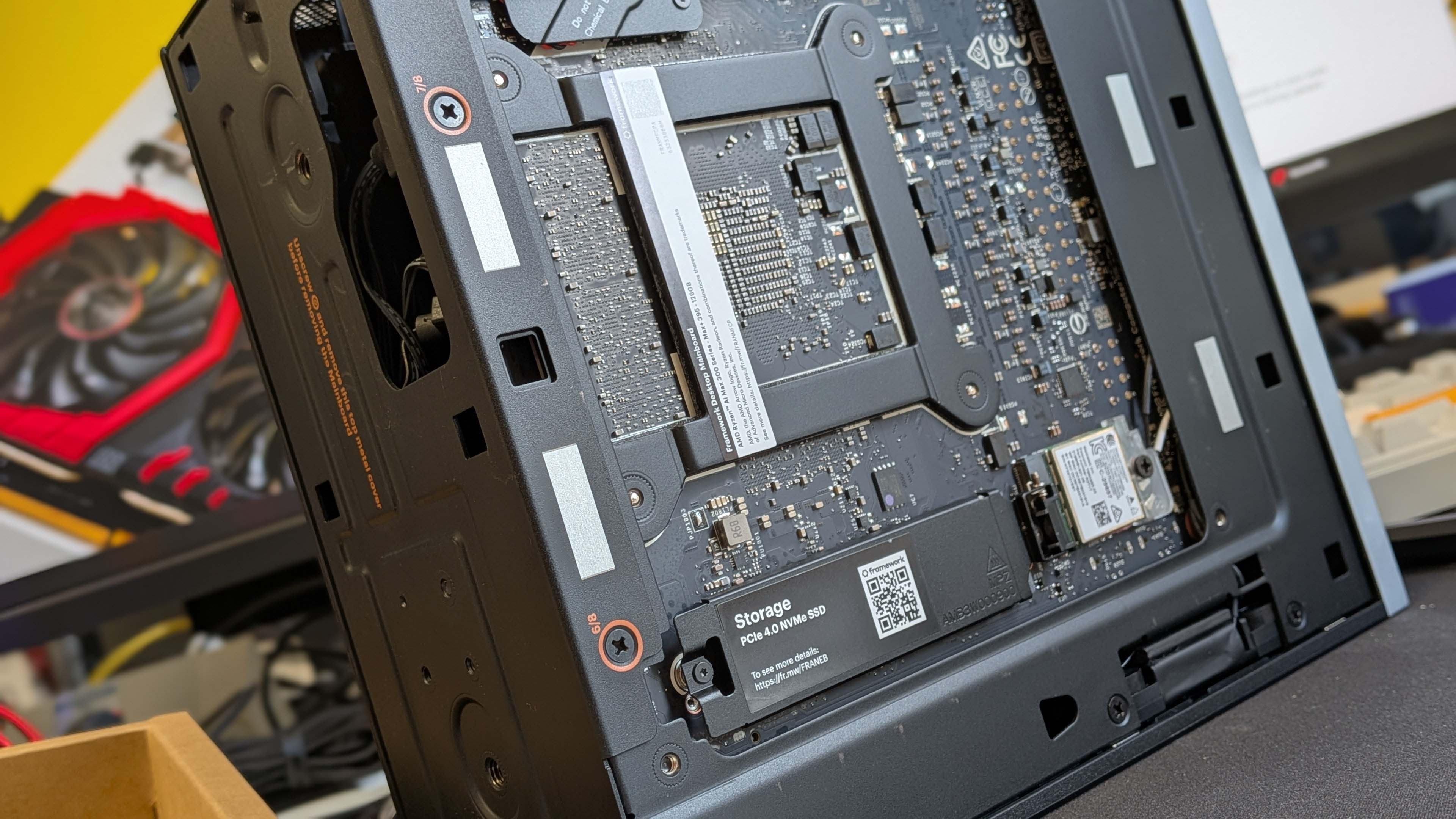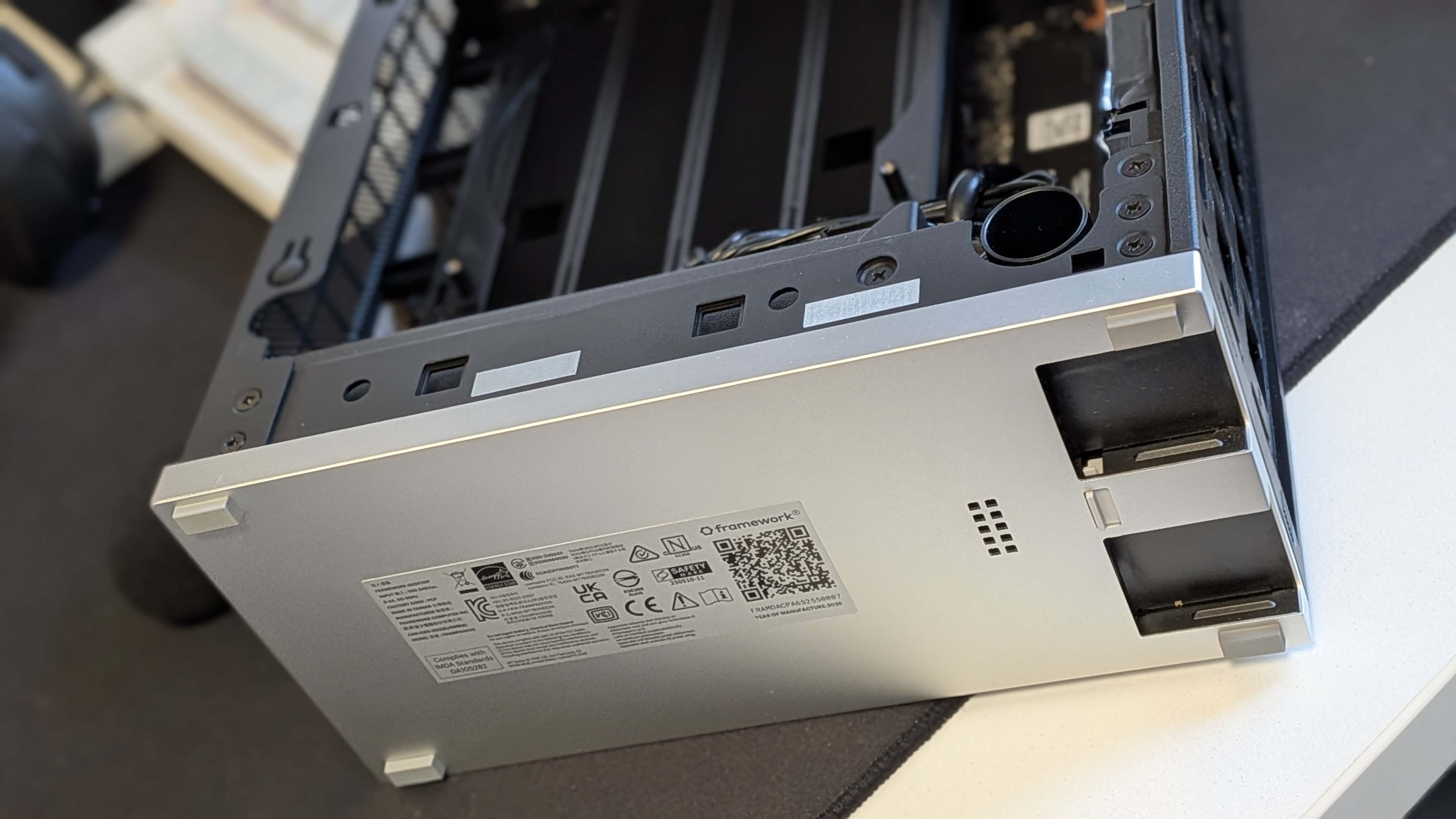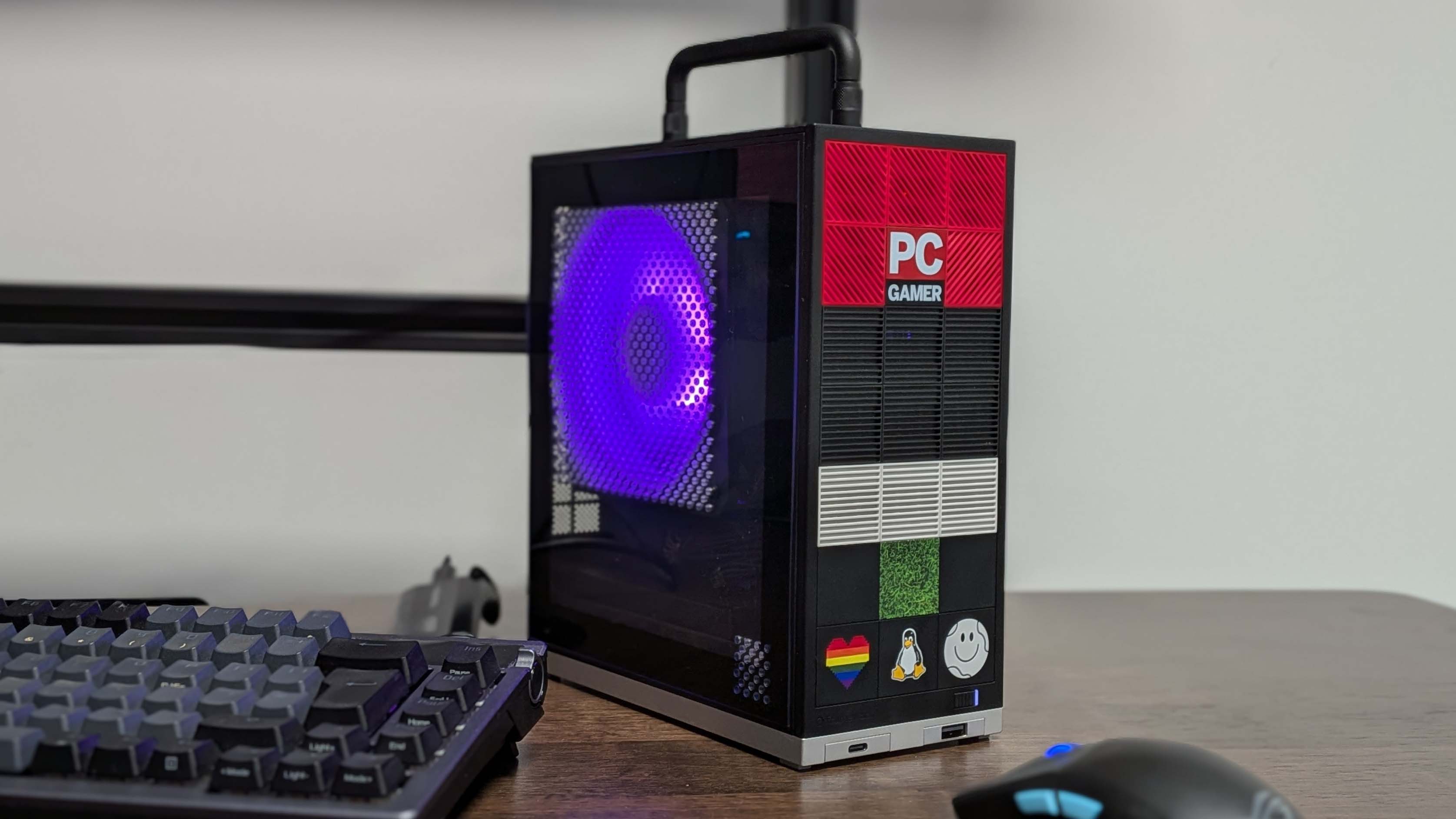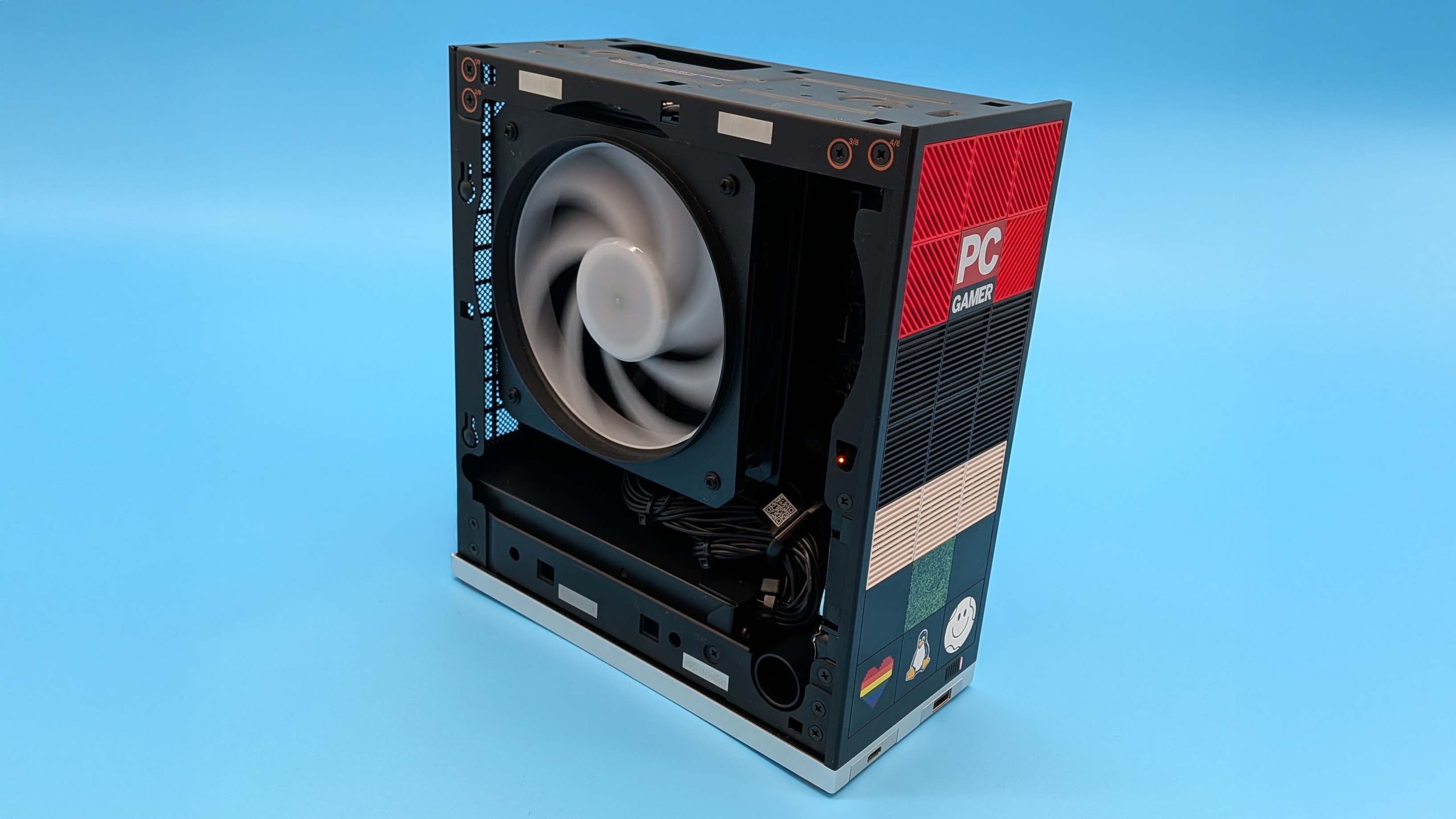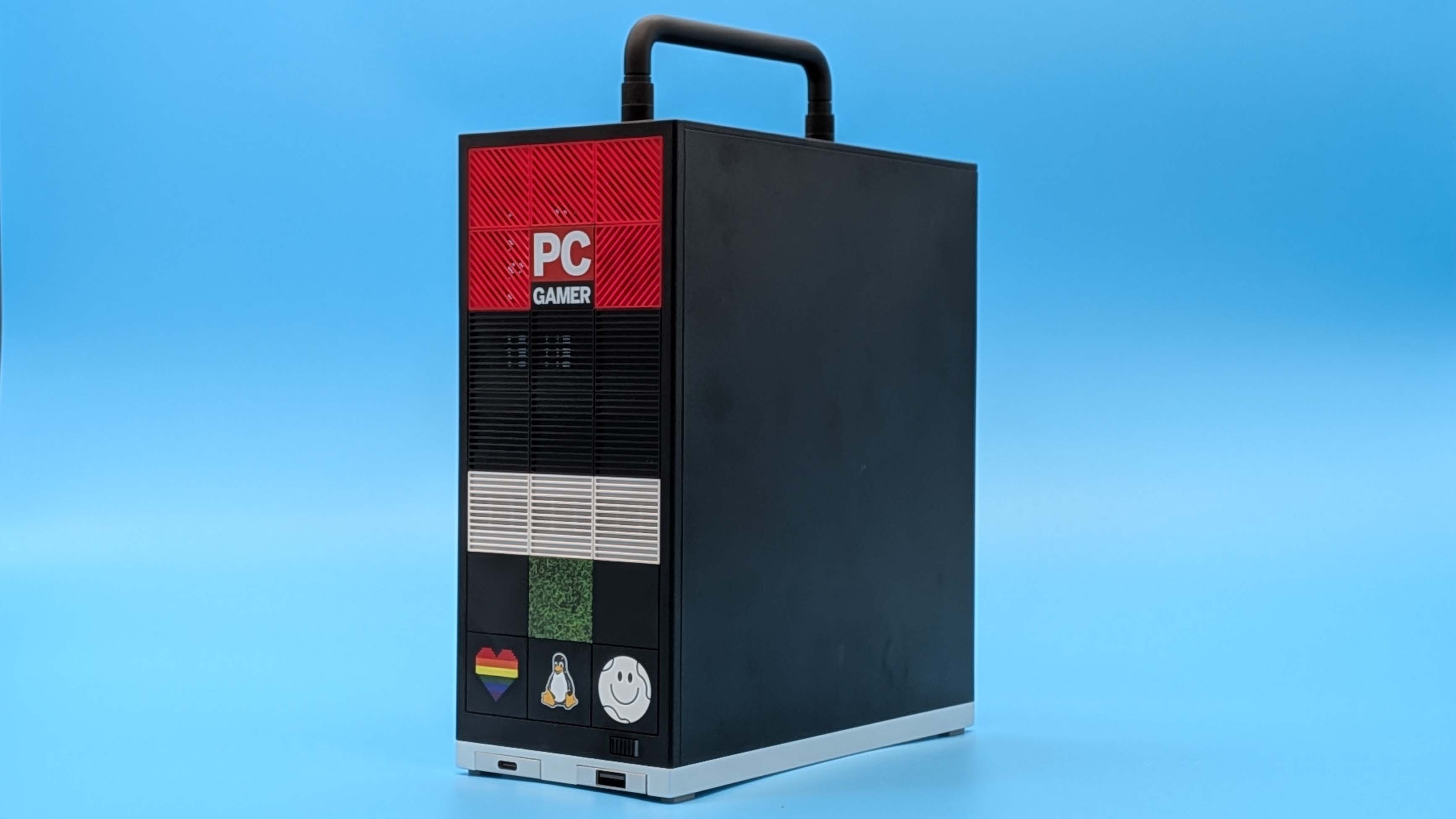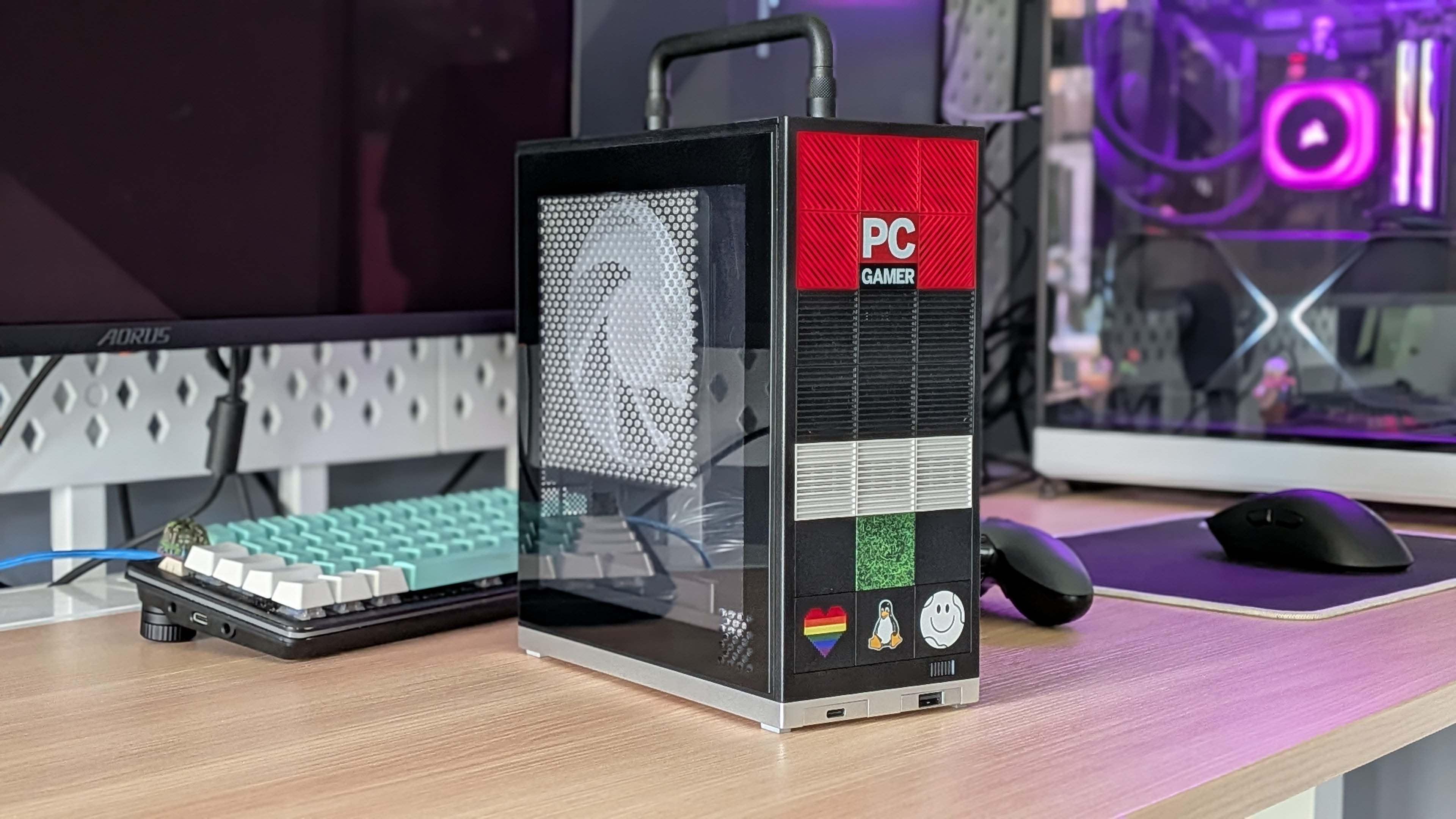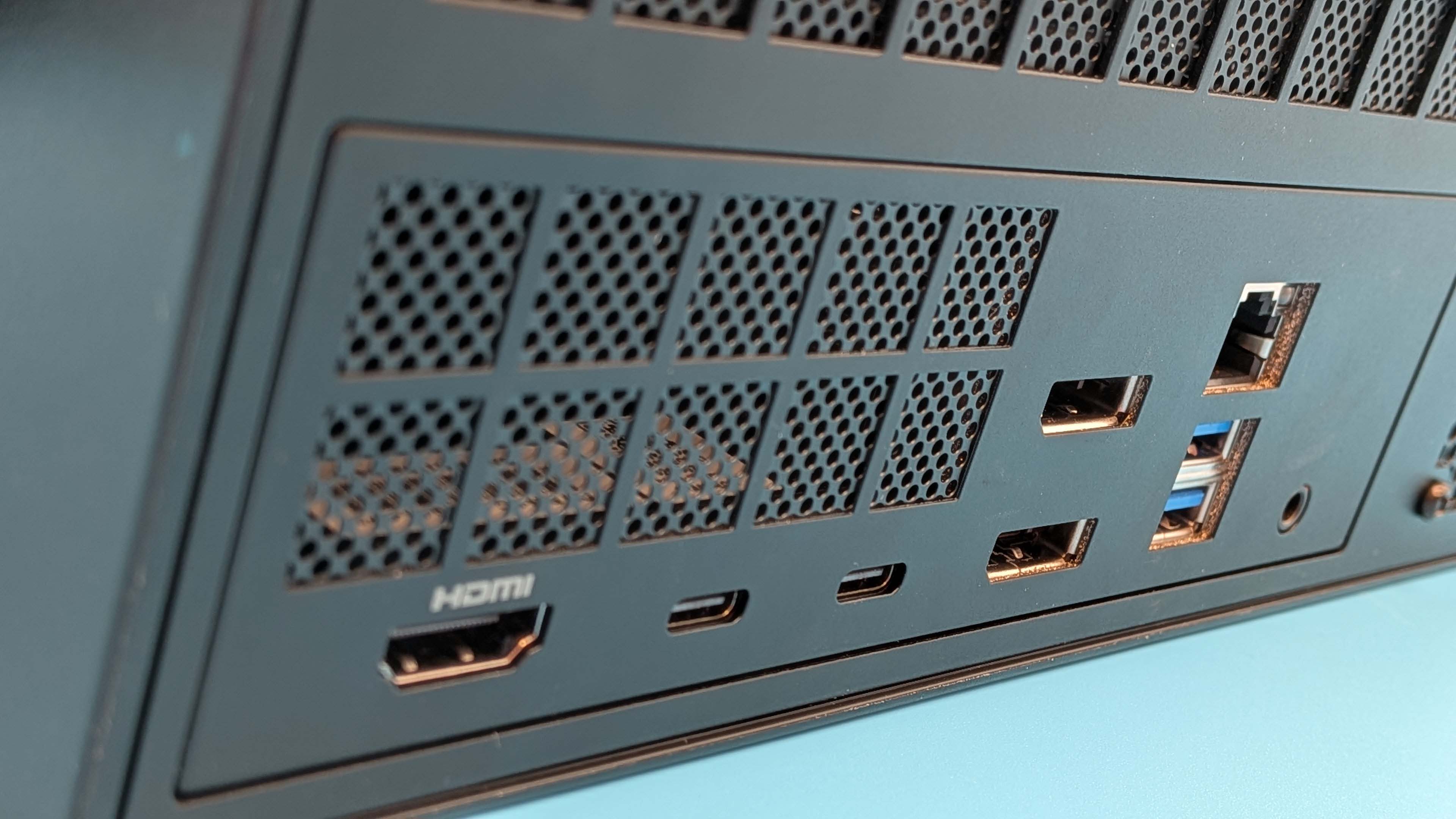Couching the expensive little Framework Desktop as “a DIY gaming rig without the pain” isn’t necessarily doing this mighty-but-tiny justice. It’s not a gaming PC, that chip isn’t a gaming chip; AMD folk have said that to us explicitly. Especially not when you can build a small form factor gaming rig for at least $1,000 less that will likely have more gaming power.
Crucially though, still not this smol. It really is a tiny thing in desktop terms, in fact I’m sneaking it out of the office tonight in my satchel bag along with my laptop. It’s not quite mini-PC smol, however, and Asus’ ROG NUC is certainly going to pop up and make a point about its own more than capable gaming performance in an even more svelte form factor.
That’s a mini rig sporting a desktop RTX 4070, very much the gaming equal of this AMD Radeon-powered Strix Halo machine.
So, maybe the “DIY gaming rig” thing isn’t the real sell. Actually, there’s no maybe about it: the Framework isn’t built for gaming—it can do it, but that’s not what it’s best at. What the Framework Desktop really is, is a miniature workstation with unprecedented AI processing power at its silicon fingertips.
Desktop specs
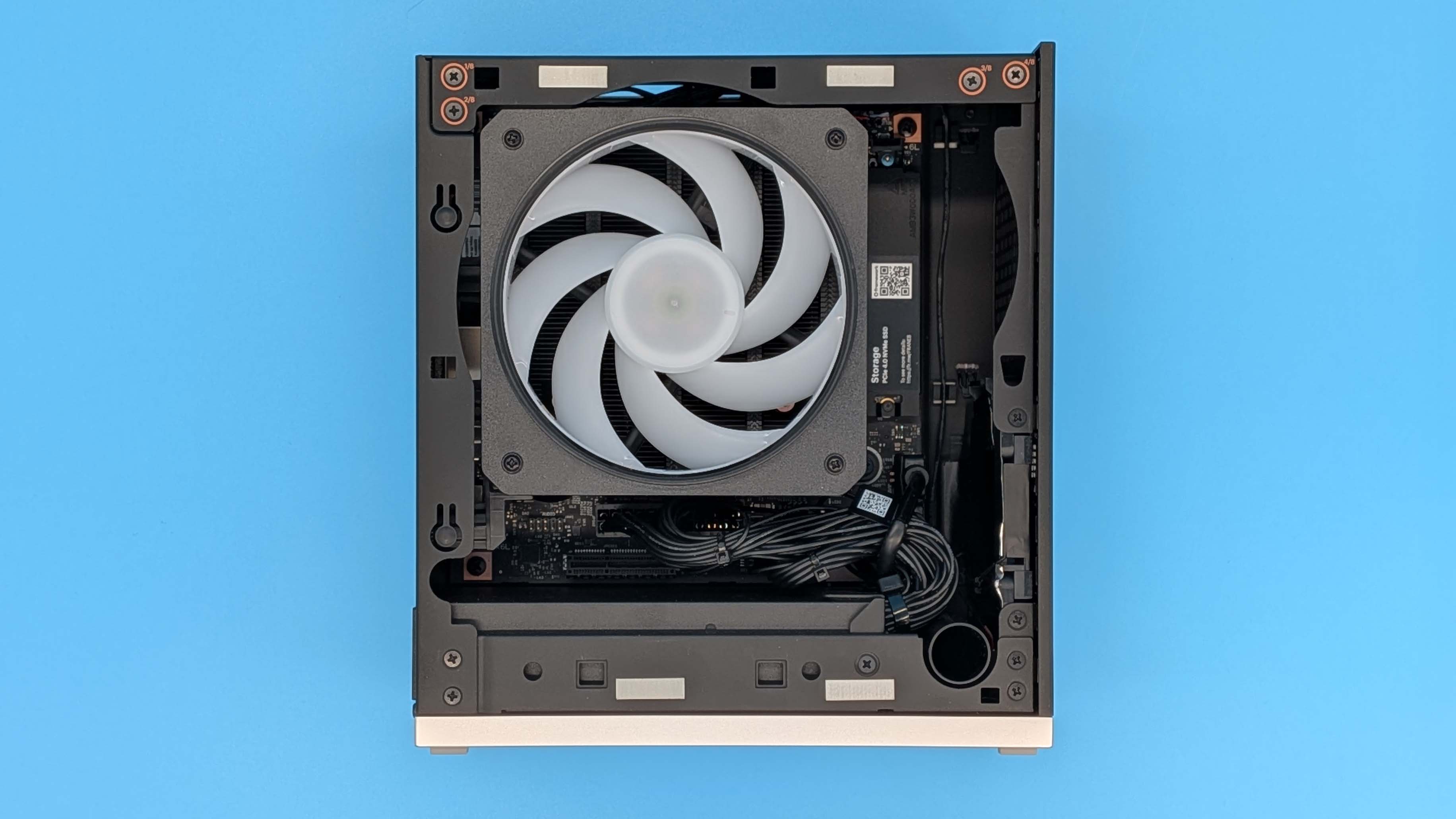
APU: AMD Ryzen AI Max+ 395
Cores | Threads: 16 | 32
Clock speed: Up to 5.1 GHz boost
GPU: Radeon 8060S
CUs: 40
RAM: 128 GB LPDDR5x-8000
Storage: 2 TB WD 7100
Rear I/O: 1x HDMI 2.1. 2x DP 2.1, 2x USB4 Type-C, 2x USB 3.2 Type-A, 1x RJ45 5 Gb, 1x 3.5 mm audio combo
Power: 120 W (140 W boost)
Dimensions: 96.8 x 205.5 x 226.1 mm
Price: $2,270 | £2,267 (as configured)
Let’s get into what’s powering this thing. Strix Halo is essentially what I’ve always wanted AMD to release since the PlayStation 5 appeared. It’s an APU that combines AMD’s Zen architecture with its RDNA GPU design, but at a level we’ve never seen on the PC desktop before. The Sony console’s APU packs in eight Zen 2 CPU cores and 36 RDNA 2 compute units (or CUs), and I’ve always wondered about what sort of thin and light gaming laptop that would make.
Strix Halo is essentially a far more advanced, CPU-heavy version of that. The top chip, this AMD Ryzen AI Max+ 395, sports 16 Zen 5 cores and 40 RDNA 3.5 compute units. There are slightly cut-down versions, which means we’ve now seen what sort of thin and light gaming laptop this silicon makes: the Asus Z13 Flow.
And now we’re not so sure it’s something we actually want.
The overall cost of the laptop/tablet hybrid, especially when you factor in price per dollar, is utterly prohibitive to such an extent that it’s hard to figure out who and what it’s for. While the PS5 was expensive in console terms, it’s not relative to a gaming PC. But Strix Halo has been such a pricey slice of silicon, to both manufacture and design, that it is certainly not going into console-priced systems.
So yes, not in a laptop, but a small form factor PC? Now you’re talking. And that’s what Framework has created, a diminutive PC with a selection of Strix Halo options that don’t have to worry about thermal constraints so much, and not at all about batteries.
If you want some reference point in terms of desktop componentry, we’re effectively looking at a slightly slower, lower power AMD Ryzen 9 9950X processor, paired with a GPU that can deliver RTX 4060 or Intel B580 levels of gaming performance. And if it didn’t cost well over $2,000 that would be a mighty compelling package for a PC gamer.
Looking at the 1440p gaming performance of this machine, it is working at the same level as those two popular budget GPUs, which is really impressive for a system without a discrete graphics component—whether that’s a mobile discrete GPU or a fully fledged desktop graphics card. But not so impressive when you think about the fact you could build a Mini-ITX gaming PC with a higher level of frame rate performance for easily $1,000 less.
And the fact that we’re talking about DIY PC builds means Framework’s original ethos behind endless upgradeability and repairability has far less potency outside of laptops. Desktop PCs are already both of those things. And, honestly, more so than the Framework with its soldered APU and soldered 128 GB memory.
In the end, that really torpedoes the Framework Desktop as a gaming PC. You can get more for less, and the draw of its diminutive size isn’t really worth that price premium in gaming terms.
I also have questions about its longevity as a platform.
Framework has proven, with its outstanding 13-inch laptops, that it can walk the walk on continued iterations of a formula, but we can probably consider the Framework 16 modular gaming laptop a failure at this point. I loved it, but there have been no further graphics modules released or even announced, and with AMD effectively exiting the mobile discrete GPU market this generation that’s effectively left it a dead-end platform.
And I fear the same could happen here. You could argue that the Mini-ITX form factor of the Strix Halo mainboard means that you can drop in a new Mini-ITX motherboard in the future, with another chip and cooler, and continue to use your Framework Desktop. But Strix Halo has been the first APU to offer this sort of gaming performance, and it’s been such an expensive thing to produce I don’t know if AMD is really going to continue developing the Halo platform.
So, you absolutely will be able to drop in a new Mini-ITX board down the line, but you’ll likely be dropping down the GPU performance ladder as a consequence.
As a “DIY gaming PC without the pain” then, it’s a bit of a bust from a price, performance, platform future perspective. But as a miniature workstation, especially for AI… hooo, mama.
This top-end version comes with that soldered 128 GB of LPDDR5x-8000, and it means this thing can handle a ton of the latest and most powerful local AI models. Honestly, outside of some AI image generation with Stable Diffusion trying to resurrect my dead uncle’s art style, I’ve not really spent much time messing around with local AI. But that’s all changed now.
With the simple LM Studio app I have a huge number of models at my disposal, including the two recently released new OpenAI models—gpt-oss-20b and gpt-oss-120b. A quick download and they’re there. Even that ~120B parameter model is workable on the Ryzen AI Max+ 395 when you pack it with this much memory. In fact, I spent the day thrashing at an Alibaba model with 235B parameters and that almost entirely filled the 128 GB of system memory—I had maybe 4 GB free at any point—and it was thoroughly usable.
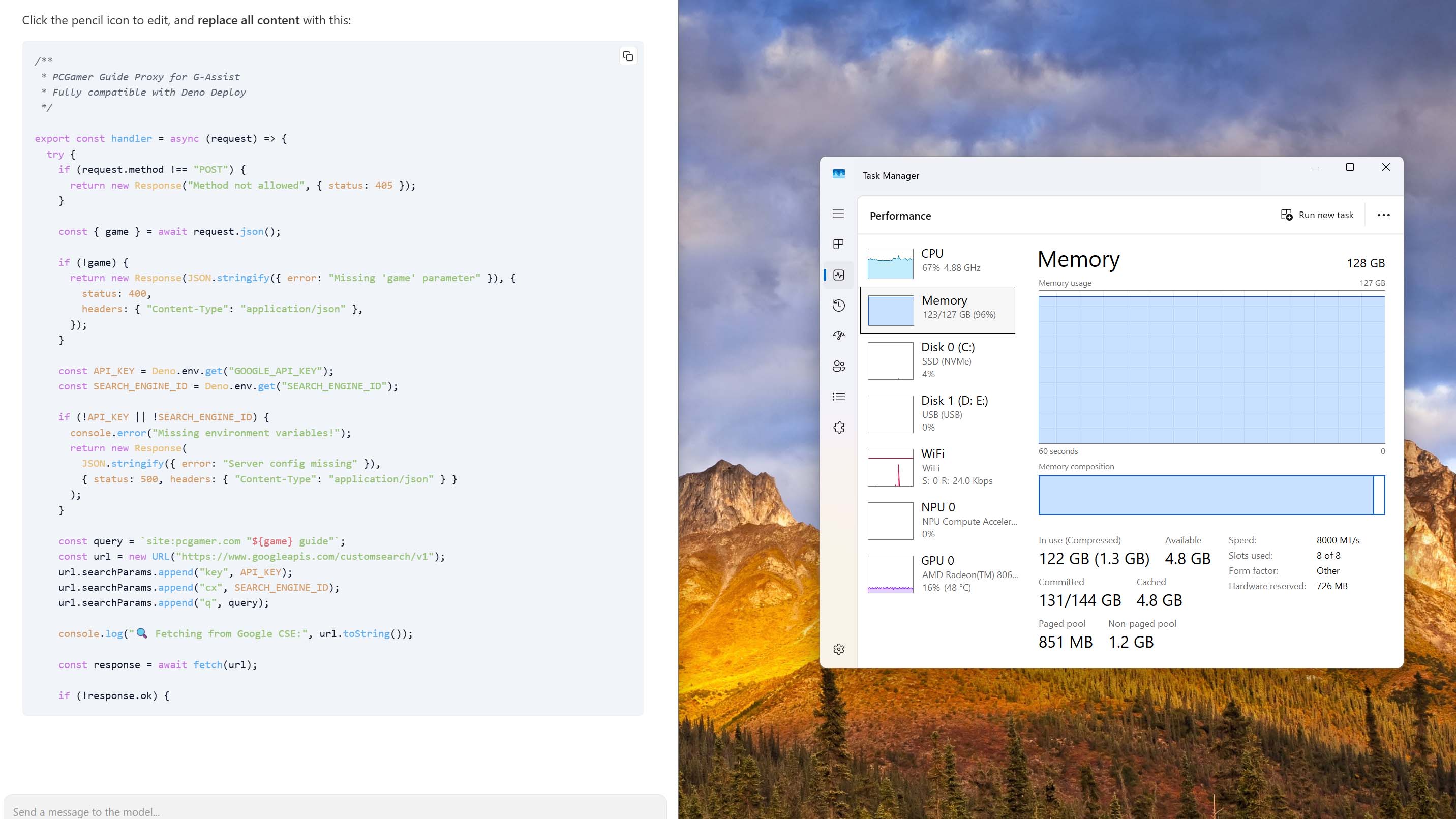
The benefits of that local AI power are pretty hefty. You’re no longer bound by any usage limits nor any concerns over security, and when you’re using these models, such as DeepSeek or gpt-oss, I can see why you might not want the creators necessarily looking over your shoulder at what you’re doing with it.
It’s this which has really caught my attention with the Framework Desktop. Sure, I can also indulge in some light gaming on the side, but that’s really not the thing that’s going to sell a $2,300 mini PC. The tiny workstation power on offer, however, really might. It’s not just on the AI side, either, to be fair—having 16 Zen 5 cores and 32 threads at your disposal in a small form factor PC is certainly going to be enticing for many content creators, too.
What’s also really enticing is what Framework has actually created here. Okay, I absolutely fell in love with this wee machine for its diminutive stature, that cute carry handle, and the customisable tiled front, but that Mini-ITX board is something that might actually have more suitors than the desktop as a whole.
You can pre-order the full Ryzen AI Max+ 395 board with either 64 or 128 GB for $1,299 and $1,699 respectively, and that will be a mobo you can drop into any other chassis you fancy. If you’ve already got a Mini-ITX system, with existing storage and PSU, dropping in the full-fat Strix Halo mainboard will get you this level of processing (and yes, gaming) power for a much more reasonable outlay.
It’s got a pair of PCIe 4.0 M.2 slots, on top and underneath, and there’s a PCIe x4 slot not exposed by the Framework chassis that you could use for slotting in more NVMe SSDs via an adapter.
My only real issue with the board itself is the paucity of USB ports. There are just two USB4 Type-C connections, and two USB 3.2 Type-A ports. You do, of course, have Framework’s innovative IO modules, with a pair of them up front, allowing you to add another two inputs, but that still gives you a six port maximum. That’s not a lot after you’ve plugged in a keyboard and mouse.
You’re going to have to make a choice over headset, mic, webcam and any other peripherals you might want to stick into your new mini workstation. An external USB hub will take care of that, but it’s a shame there aren’t more connections in the first place.
Buy if…
✅ You want a small workstation: With the 16-core Zen 5 chip and 128 GB of system memory, the Framework Desktop is a supremely powerful compute and local AI processing device.
Don’t buy if…
❌ You’re just after a small gaming PC: Yes, it will deliver decent gaming performance, but only on par with systems only a little larger which would cost $1,000 less.
❌ You want a system that can grow: If you want to change anything apart from the SSD, it’s a full motherboard swap, and I’m not convinced yet there will necessarily be a follow up.
It’s such an attractive thing, I really do want to love the Framework Desktop, and there is a lot to love about it. The chip itself is a hugely impressive technical feat, the Mini-ITX mobo is a treat, and the level of processing (AI or otherwise) on offer is pretty spectacular. But, like the other Strix Halo machine we’ve tested, the Asus Z13 Flow, I can’t escape the fact it’s a pretty niche, very expensive device. There is more utility here than with the weird super tablet, but you’ve really got to want this form factor and that level of compute potential to make it worthwhile. And want it enough to not even really think about the price premium.
But for gaming? Look, I know it’s there in the Framework marketing—with carefree genzedders at an impromptu LAN party or sitting on the floor at their nihilistic, don’t-give-a-fuck desktop setup—but while you can play games on it, that’s never going to make it a gaming PC first and foremost. Not at this price.
But if you’re after a resolutely mini PC form factor for your local AI gruntwork, and hang the price, then the Framework Desktop is going to be absolutely your thing. Such is its charm, it almost made itself my thing. Almost.


